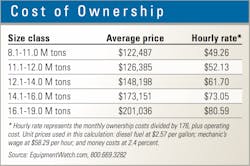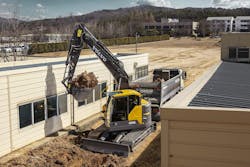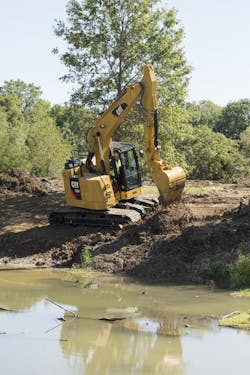For Mid-sized Excavators, It's Swing Time
The market for crawler excavators from 20,000 to 40,000 pounds, or roughly 9 to 18 metric tons, is relatively strong, and reduced-tail-swing models, as well as performance and efficiency improvements from OEMs, have driven the popularity.
“It’s a tale of a few different size classes within that grouping,” says Andrew Dargatz, brand marketing manager for Case Construction Equipment. “As a whole, excavators between 10 and 14 metric tons are down compared to previous years, and that’s a pretty consistent trend going back three years. Excavators ranging from 14 metric tons up to 16 metric tons have grown considerably. There were more than double the number of excavators in that size range sold in 2017 than there were in 2015, and those ranging from 16 to 19 metric tons have fluctuated for the last few years—down last year, but up this year, and still lower than 2015.
Increased capabilities and efficiencies are also boosting the market.
“Improvements made to excavators in this size class in hydraulics and speed are also allowing these machines to dig and lift more than they could in the past,” Dargatz continues. “That’s specifically true of the minimum- swing-radius machines, which is why they’re stealing volume from the larger conventional designs.”
David Young, product marketing manager, excavators, for John Deere and Hitachi, agrees on the growth.
“This size class that we’re referring to is the fastest- growing market segment in North America today,” he says. “It is growing quickly. I think the reason this segment is growing is the mobility factor these excavators bring to the job site. They are productive, and relatively small, making them easy to transport. A lot of mid-sized contractors that bid a variety of jobs are drawn to this size class because of their transportability. These machines are also becoming more productive with technology developments and machine engineering.”
Feature-wise, the size class has come a long way in a fairly short time.
“Ten years ago, short-swing-radius (SSR) machines were just coming out, and while functional, they were designed around one task only—don’t stick out in traffic,” says Matthew McLean, GPE product manager for Volvo. “Some performance characteristics and operator comfort were clearly second-hand considerations. The cab environment on SSR excavators has gotten more sophisticated in the latest generation. Instead of tiny boxes, SSR cabs have increased room for their operators, wider doors, and drastic improvements in the HVAC capacity. The latest models have very good weight balance while keeping the operator comfortable.”
"The cab environment on SSR excavators has gotten more sophisticated in the latest generation." - Matthew McLean, Volvo
When it comes to buying excavators in the size class, transport is a big consideration.
“First, this size class is a transition from compact excavators to mid-size crawler models,” says Aaron Kleingartner, marketing manager for Doosan. “It’s also the start of the heavy excavator lineup for many equipment manufacturers. A common first question to ask is how will the excavator be transported? Will a contractor use his truck or lease trucks to move excavators? If a contractor moves up to this size class from a compact excavator, the owner may be required to get a CDL. It’s important for owners to confirm the transportation requirements with their local DOT because requirements may vary state by state.”
After transportability, consider the size of the swing.
Andrew Earing, Komatsu’s product marketing manager for excavators, also points to transportation and versatility. “If job sites are primarily in urban or densely populated areas, the short-tail excavator is a good choice due to the reduced swing radius,” Earing says. “If the job sites are primarily in rural areas or include tasks such as basement excavating, then a conventional excavator may be the better choice due to greater lift capabilities and deeper dig depths. Transportation is also important because most tag trailers have a 40,000-pound weight limit. Equipment exceeding this weight will require alternative means of transportation and possibly additional permits.”
How the machine needs to be outfitted is also a factor.
“For example, the availability of rubber track pads will be important for roadwork applications, and a dozer blade is important for backfill or grading applications,” says Tyler Peterson, JCB’s product manager for large excavators.
Takeuchi product manager Michael Shebetka focuses on attachments with a series of key questions for managers: “What type of work do you plan on doing with the excavator? Will you need auxiliary hydraulics for attachments? What are the parameters of certain attachment requirements such as pressure and gallons per minute on flow?
“How much weight you plan to attach to the end of the arm also is important,” Shebetka says. “Adding a bucket or attachment plus a hydraulic coupler and a hydraulic-mounted thumb can add an excessive amount of weight that can easily throw a machine out of balance when dumping material or working over the side of your track.”
Once a unit is selected for the fleet, there are a number of things managers can do to keep costs down for an excavator in the size class. As always, start with maintenance.
“Grease and generally take care of the machine to maximize its productivity and working life,” says Mike Popovich, VP of excavator products at Gradall. “And proper training for operators and anyone doing maintenance is important to make sure maintenance is done right and on schedule, and to make sure operators use the machine properly.”
Young advises managers to know what pieces of iron are required on the job site. “Costs go up when extra equipment is transported to the site that isn’t needed. A good fleet manager will know exactly what they need to get the job done to avoid unnecessary transports, and keep costs down,” he says.
Managers should watch idle time, too, with an assist from technology.
“Utilize the telematics systems now offered by most equipment manufactures to start with,” Shebetka says. “Telematics is an excellent tool for companies of any size, especially for large fleets and multiple operators. It can track and record an operator’s time management and operating habits. It can also track the machine’s location, monitor the machine’s vitals, and send alerts when there is a problem or scheduled maintenance due. Another way is to promote ‘Operator Ownership’ of a specific machine. [That’s where it’s] assigned to one operator who’s responsible and accountable for that particular machine’s overall health and condition. Multiple operators for one machine is usually where problems start—no [one person has] accountability.”
Most manufacturers are predicting the future of the 20,000- to 40,000-pound size class will see increasing incorporation of telematics and technological capabilities, such as machine control to help operators with dig depths and levels, and safe boom operation.
“As with most technologies, there is a cascade effect,” McLean says. “Features that are the domain of the bigger machines work their way down to the smaller models. Systems that assist operators with digging trenches are quite common on the 21- through 24-ton-class machines today, and are expected to start showing up in this class of machines as soon as the volumes go up and system costs come down, making them an affordable option to add.”



